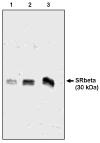Catalogue

Sheep anti Dog SR beta
Catalog number: Z115P| Isotype | IgG |
| Product Type |
Polyclonal Antibody |
| Units | 250 µg |
| Host | Sheep |
| Species Reactivity |
Chicken Dog |
| Application |
Immunohistochemistry Western Blotting |
Background
The receptor for Signal Recognition Particle (SRP) is the site on the endoplasmic reticulum that ribosomes translating secreted and integral membrane proteins are initially targeted to. Once the ribosome-SRP complex arrives at the SRP receptor the protein being translated is transferred to the translocation complex (Sec61) in the ER membrane. The SRP receptor is composed of two subunits SRalpha and SRbeta. The SRalpha subunit is a translocation GTPase peripherally bound to the endoplasmic reticulum by its interaction with SRbeta. SRalpha also binds to the GTPase of SRP (SRP54) and these two proteins appear to function as each others GTPase activating proteins (GAPs). Hydrolysis of GTP by SRalpha and SRP54 is thought to be involved in transfer of the nascent protein to the Sec61 complex in the ER. SRalpha has an apparent molecular weight of 72 kDa. SRbeta is a Type I transmembrane protein that spans the membrane once and contains Ras type GTPase domain. The function of the GTPase in SRbeta is unknown. The membrane spanning domain is at the amino-terminus of SRbeta. The GTPase domain encompasses three quarters of the protein and is carboxyl- of the transmembrane region. SRalpha binds to the GTPase domain of SRbeta. Heterodimerization of SRalpha and SRbeta masks the carboxyl-terminal epitope of SRbeta.
Synonyms: Signal Recognition Particle Receptor, β subunit
Source
Immunogen: Synthetic peptide corresponding to amino acids 246-265 derived from the carboxyl terminal of the canine SRbeta subunit.
Product
Product Form: Unconjugated
Formulation: Provided as solution in phosphate buffered saline with 0.08% sodium azide
Purification Method: Ammonium Sulfate Precipitation
Concentration: See vial for concentration
Applications
Detects SRbeta by Western blot analysis at 15 µg/ml. Antibody will not detect SRbeta protein bound to SRalpha. Optimal concentration should be evaluated by serial dilutions.
Functional Analysis: Western Blotting
Positive Control: Canine microsomal protein
Storage
Product should be stored at -20°C. Aliquot to avoid freeze/thaw cycles
Product Stability: See expiration date on vial
Shipping Conditions: Ship at ambient temperature, freeze upon arrival
Caution
This product is intended FOR RESEARCH USE ONLY, and FOR TESTS IN VITRO, not for use in diagnostic or therapeutic procedures involving humans or animals. It may contain hazardous ingredients. Please refer to the Safety Data Sheets (SDS) for additional information and proper handling procedures. Dispose product remainders according to local regulations.This datasheet is as accurate as reasonably achievable, but Nordic-MUbio accepts no liability for any inaccuracies or omissions in this information.
References
1. Bacher, G., et al. The ribosome regulates the GTPase of the beta-subunit of the signal recognition particle receptor. J. Cell. Biol. 1999, 146, 723-730.
2. Ogg SC, et al. A functional GTPase domain, but not its transmembrane domain, is required for function of the SRP receptor beta-subunit. J. Cell. Biol. 1998, 142, 341-354.
3. Young, J.C., et al. An amino-terminal domain containing hydrophobic and hydrophilic sequences binds the signal recognition particle receptor alpha subunit to the beta subunit on the endoplasmic reticulum membrane. J. Biol. Chem. 1995, 270, 15650-15657.
Safety Datasheet(s) for this product:
| NM_Sodium Azide |

|
"Western blot analysis using SRβ antibody (Cat. No. Z115P) on 3 (1), 6 (2) and 12 (3) ng of canine microsomal protein" |

"Western blot analysis using SRβ antibody (Cat. No. Z115P) on 3 (1), 6 (2) and 12 (3) ng of canine microsomal protein"
